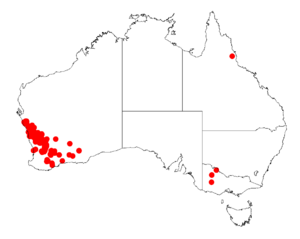Dwarf myall
Quick facts for kids Dwarf myall |
|
|---|---|
| Scientific classification | |
| Genus: |
Acacia
|
| Species: |
lineolata
|
 |
|
| Occurrence data from AVH | |
The Dwarf myall (Acacia lineolata) is a special kind of shrub. It belongs to the Acacia family, which is also known as wattles. This plant is found only in a specific part of southwestern Australia. It's called "dwarf" because it's usually a smaller shrub.
What Does Dwarf Myall Look Like?
This shrub usually grows to be between 0.5 and 2 meters (about 1.5 to 6.5 feet) tall. It has many branches and often grows in a round or cone shape. Its young branches can be smooth or a little bit hairy.
Like most Acacia plants, the Dwarf myall doesn't have regular leaves. Instead, it has "phyllodes." These are flattened leaf stems that look and act like leaves. The phyllodes of the Dwarf myall are tough and smooth. They are always green and grow outwards or upwards.
These phyllodes are long and narrow, like a line or a thin oval. They are about 2 to 6.5 centimeters (0.8 to 2.5 inches) long and 2 to 5 millimeters (0.08 to 0.2 inches) wide. You can see many thin, yellow lines running along them. The Dwarf myall blooms with yellow flowers from June to September.
Types of Dwarf Myall
The Dwarf myall is part of a group of wattles called the Acacia enervia group.
There are two main types, or "subspecies," of Dwarf myall that scientists have identified:
- Acacia lineolata subsp. lineolata
- Acacia lineolata subsp. multilineata
Where Does Dwarf Myall Grow?
This shrub grows naturally in certain areas of Western Australia. These areas include the Wheatbelt, Great Southern, and Goldfields-Esperance regions.
You can often find Dwarf myall growing on sandy plains, in salty flat areas, and in low-lying spots. It likes to grow in rocky clay, salty loam, or sandy soils. The plant's natural home stretches from around Yuna in the northwest to Pingrup in the southeast.

